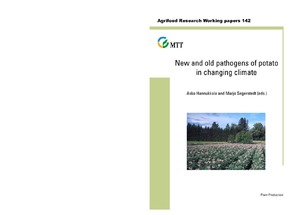Why is Erwinia chrysanthemi (Dickeya sp.) taking over? The ecology of a blackleg pathogen
Wolf, Jan van der; Speksnijder, Arjen; Velvis, Henk; Haar, Jan van de; Doorn, Joop van (2007)
Wolf, Jan van der
Speksnijder, Arjen
Velvis, Henk
Haar, Jan van de
Doorn, Joop van
Julkaisusarja
Agrifood Research Working papers
Numero
142
Sivut
s. 32
MTT
2007
Tiivistelmä
Erwinia chrysanthemi (Ech) is causing large problems in potato production and is responsible for increasing incidence of blackleg in Europe. In 2005, when the temperature was high during the growing season, Ech was responsible for 50-100% of blackleg cases in France and The Netherlands. Also in 2006, the relative incidence of potato diseases caused by Ech was high. In this paper some ecological aspects of Ech are discussed which may explain the increasing significance of this pathogen. Ech has been renamed recently and various strains are now distributed among six different Dickeya species. In potato, different Dickeya species have been found in Europe, viz. D. dianthicola, D. dadantii and D. zeae. Furthermore, Dickeya strains have been found in potatoes grown in Israel, which could not be classified in any of the six new species. D. dianthicola (Dcd) causes blackleg in temperate zones, whereas the other species are associated with potato diseases in warm climates. We have indications that due to increasing temperatures, the warm climate Dickeya species are taking over Dcd. Possibly these species are more virulent, which may explain the increasing dominance of Dickeya spp. in current blackleg epidemics. Dickeya sp. seem to act like biotrophic organisms, which need the host for long-term survival. Dcd survived poorly free in soil. Different strains were found to survive for one week but not three weeks after being inoculated into different soil types (sand, clay and peat) kept at different temperatures and humidities. In contrast Pectobacterium atrosepticum (Pca) and Pectobacterium carotovorum subsp. carotovororum survived for three months. Also survival was poor on various material surfaces (rubber, iron, aluminium, PVC, wood, concrete); Dickeya populations survived only three days on such surfaces and two weeks in the presence of plant extracts. However, Dcd has been frequently found in surface water, suggesting that it can persist for long periods in water. Dcd is able to cause disease symptoms even when present in seed at low densities. In field experiments with vacuum-inoculated tubers a level of 40 cells per gram of potato peel was sufficient to end up with 30 and 15% diseased plants in 2005 and 2006, respectively. Such low levels of infection easily remain unnoticed during seed testing, even if sensitive detection methods are used. As for Pca, spread of contamination within and between seed stocks often occurs during harvesting and grading. In an experimental field, contamination with Dcd was spread by mechanical harvesting up to a distance of 80 m behind a zone with rotten tubers, with an average of 12 meter. Hand-harvested tubers from a disease-free crop remained clean. Spread within a crop may also occur during crop production if Dickeya spp. are disseminated via free water in soil from rotten tubers to tubers of adjacent plants. We showed that plants adjacent to blackleg diseased plants both within a row and between rows became contaminated after heavy irrigation.
Collections
- Julkaisut [87135]
